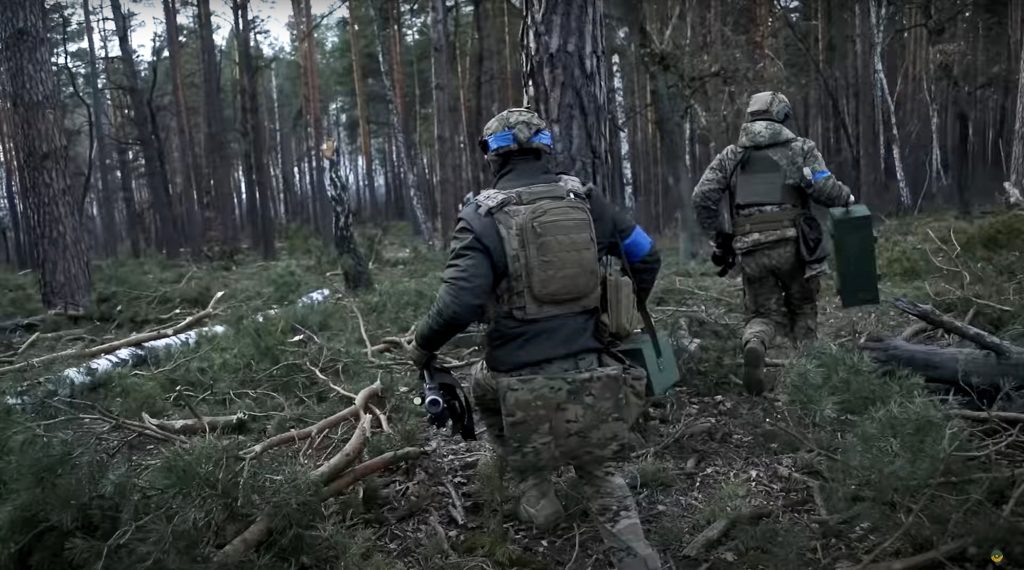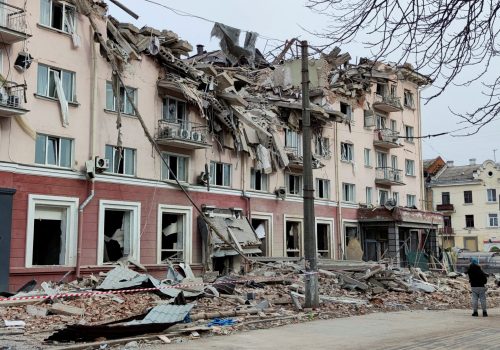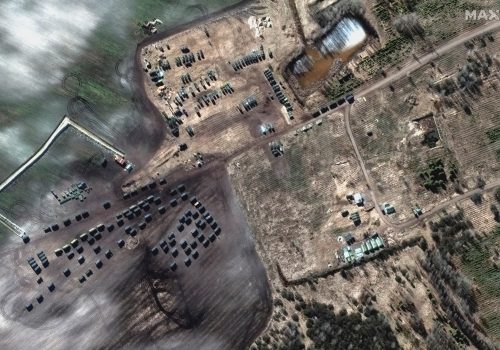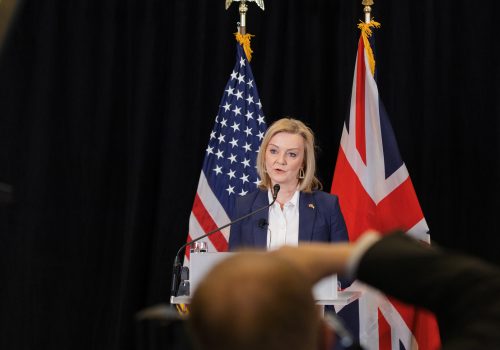In light of the ongoing Russia crisis, the Scowcroft Center’s Forward Defense (FD) practice will share weekly assessments of the latest force developments surrounding Ukraine, leveraging the expert perspectives of our senior military fellows. The opinions, conclusions, and recommendations expressed or implied here are solely those of the authors and do not represent the views of the Department of Defense or any other US government agency.
The bottom line
The war has transitioned from a lightning offensive designed to take the capital (if not the whole country) to a brutal war of attrition designed to suffocate Ukraine. In the north, Russia is transitioning into siege tactics around Kyiv, and the immediate risk of Ukrainian defeat seems to have passed. Still, Russia has adopted the so-called Grozny tactics of indiscriminate attacks on civilian areas and near-complete razing of cities. In the south, Russia is using such tactics to demolish Mariupol, and it is nearly finished reinforcing the land bridge from Crimea to the Donbas. Russia will soon turn to Odesa and try to establish a land bridge from Crimea to the Transnistria region of Moldova. Once these objectives are achieved, we assess that Russia will likely settle into a war of attrition, starving Ukraine of supplies, blocking access to the Black Sea, and eventually prompting famine as Ukrainian farmers are unable to tend to their harvest.
Russian military movement
Air and air defense: Russia has still failed to establish air superiority and is suffering huge aircraft losses as a result. The Russian Air Force has noticeably increased its missile attacks on targets in the far west of Ukraine and will likely continue to back up threats against US and European resupply of Ukrainian forces with attacks near the Polish border. We find it highly unlikely that either side will establish air superiority over Kyiv in the coming week or that Russia will be able to successfully prosecute an air or missile attack against supply lines into Ukraine.
- Continued unsustainable loss of aircraft and helicopters. According to the Ukrainian Ministry of Defense, Russia has now lost eighty-one planes, ninety-five helicopters, and nine unmanned aerial vehicles. Though all Ukrainian kill claims cannot be independently verified, numerous photos and videos confirm many of the Russian aircraft losses. The bulk of aircraft losses are believed to be from surface-to-air missiles (SAMs), including from the mobile, long-range S-300 (aka SA-10) and from shoulder-fired man portable air defense systems (MANPADS) such as the Stinger missile supplied by the United States. Russia has not made the elimination of mobile SAMs a priority, nor has it pressed for the complete destruction of Ukrainian fighter aircraft. Finally, Russia has not modified its ground-attack tactics and is conducting many of its attacks at low altitude, which puts Russian planes in the lethal envelope of MANPADS. Taken together, these factors have prevented Russia from establishing air superiority and fully supporting a ground invasion force.
- Current air activity. Russia is still flying approximately two hundred sorties per day, though many of those combat missions remain outside of Ukrainian airspace, while the Ukrainian Air Force, which is down to approximately fifty-six combat aircraft, is flying just five-to-ten sorties per day.
- Russian air strike on Yavoriv training base. On March 13, Russia executed an air-launched cruise missile attack on a Ukrainian training base only ten miles from the Polish border. The base has previously been used by the United States and other NATO nations to train Ukrainian forces on NATO weapons standards. A detachment of Florida National Guard troops left the training base in February prior to Russia’s invasion. The Yavoriv strike demonstrated Russia’s ability to hit any target in the far-reaching corners of Ukraine, and we believe it was designed to send a clear message to the United States and NATO that the Kremlin will not accept further NATO intervention.
- Supply lines in the crosshairs. On March 12, Russia threatened to target US and European weapons supplies to Ukraine. Despite the aggressive rhetoric, Russia currently has almost no capability to successfully interdict supplies coming into Ukraine through its western border with Poland. So far, the Russian Air Force has shown almost no ability to find, identify, and destroy mobile targets. The fact that the mobile S-300 SAM systems are still operating is a powerful indictment of Russia’s ability to conduct dynamic or time-sensitive targeting. Additionally, attacks in the far west of Ukraine appear to be missile as opposed to air strikes. It is unlikely that the Russian Air Force would be able to hit supply convoys by air attack, and missiles fired from hundreds of miles away would not be able to hit mobile targets. Thus, Russia has almost no ability to prevent mobile resupply.
Ground forces. As the conflict transitions to a war of attrition, Russia is adjusting its strategy and has settled on siege tactics to exert maximum pressure. Russia will increasingly target external materiel and personnel support to Ukraine, including humanitarian aid shipments. Additionally, it will likely spin up its logistics systems to sustain its forces during a protracted war.
- Siege warfare. Russia is employing siege tactics against major cities to force Ukraine to capitulate. So far, Russia has demonstrated only minor concern for friendly casualties and no regard for enemy or civilian casualties. Russia recently stated that any weapons shipments from the West are legitimate targets, a statement likely meant to stoke NATO fears of escalation and slow down plans for further shipments.
- Russian logistics. There are reports that Russia requested military equipment and aid from China after beginning its invasion of Ukraine. This suggests that Russia has not fully mobilized its military-industrial complex to support an extended campaign. As the war drags on, we expect Russia will kick its materiel and personnel resupply systems into a higher gear to sustain its forces.
- Risks for escalation. As Russia increases its attacks on western Ukraine, the risks for escalation with NATO compound. NATO and Russia should redouble efforts to open lines of communication to protect against unintended consequences.
- Information warfare. Russia is mostly allowing humanitarian corridors into Russia or Belarus, places few Ukrainians want to go, and using them as a propaganda tool. Russia is also heavily limiting freedom of speech and the press for Russian citizens, manipulating public support in anticipation of a long war. Externally, Russia is losing the information war. Ukraine’s leadership is countering Russia with impressive strategic communications, resulting in a rapid acceleration of materiel aid that should help Ukraine extend its resistance.
Naval forces. Russian forces continue to enjoy the most success in the south, where they are aided by their naval superiority in the Black Sea. Russia will continue to attack west along the coast to complete the land bridge from Donbas. We predict that Odesa is the next target for Russian forces. As Ukraine’s largest port, it accounts for 80 percent of the country’s maritime commerce, and its loss would render Ukraine landlocked.
- Naval warfare. Ukraine claims to have hit a Russian naval vessel, the Vasily Bykov, the lead ship of the Project 22160 class of patrol vessels with BM-21 Grad 122 mm multiple launch rocket systems (MLRS). If correct, this would represent the first Russian Navy loss of the conflict.
- Amphibious operations. We assess the likelihood of a Russian attempt at an opposed amphibious assault against Odesa as low. The Russians have no combat experience with amphibious assaults and lack the ship-to-shore connectors to effectively execute one against a well-defended position. A more likely scenario is that Russian Naval Infantry adds its combat power to the ground offensive already underway. If any landing takes place, it is likely to be unopposed and then require the landing force to move over land to join with the main effort before attacking. The only rationale for an unopposed landing would be to demonstrate the capability. The poorly planned and poorly executed Russian airborne assault on Antonov Airport early in the war highlighted the folly of trying to use capabilities ill-suited for the tactical reality on the ground. An amphibious operation against Odesa would be a similar error, but an even more costly one.
- Ground-based anti-ship missiles. The Norwegian Naval Strike Missile (NSM) is currently fielded by Norway, Poland, and the United States and could easily be delivered to the Ukrainians by one of those countries. The system is mobile and has a range of one hundred nautical miles. NSM deployment around Odesa has the potential to disrupt Russian naval support for the Kremlin’s southern offensive.
Subscribe to our weekly military assessment
Sign up for updates from Forward Defense to hear the latest on the trends, technologies, and military challenges shaping tomorrow.
US, allied, and partner deployments
Materiel supply to Ukraine. Sea supply routes into Ukraine remain completely cut off and aerial resupply remains severely restricted, but ground resupply routes remain open (mainly through Poland and Romania). We expect that Russia will prioritize interdicting external resupply into Ukraine in the next week, including through aerial and artillery bombardment, ambushes, and sabotage of rail lines.
What equipment does Ukraine really need? Amid the publicity of the on-again, off-again deal to send MiG-29 fighter jets from Poland to Ukraine, the focus of future security assistance has centered primarily around aircraft. With only fifty-six combat aircraft still available, the Ukrainian Air Force would certainly benefit from an infusion of fighter jets to contest Russian air superiority. However, we do not believe fighter jets are the most critical equipment the Ukrainian military needs right now. Our assessment is that ground-based air-defense assets, counter-fire capabilities, and unmanned aerial vehicles (UAVs) would have a more immediate and significant impact on the conflict than would more fighters. We assess that these three critical needs could be filled by the United States, NATO, and/or the European Union:
- Air-defense assets. Ukraine’s success in denying Russia air superiority has been much more due to ground-based air-defense assets than fighter aircraft. The Soviet-built S-300 SAM has been highly effective in the war so far. The mobile, long-range system continues to inflict losses on the Russian Air Force three weeks into the conflict. Three NATO nations—Bulgaria, Greece, and Slovakia—operate the S-300. The transfer of these systems, which Ukrainian forces know well, would complement low-altitude MANPADS such as Stingers and provide a potent anti-air capability that would have a much more significant effect in preventing Russian air superiority than additional MiG-29s. Reports on Wednesday indicated that the United States and NATO allies are now sending more S-300s.
- Counter-fire capabilities. Russia’s failure to develop localized air superiority has prevented it from leveraging its numerical and technological superiority in the air to fully support its ground invasion. The preponderance of death and destruction, however, is from ground fires such as MLRS, long-range artillery, and mortars. The best means to reduce the rate of fire and destruction from these systems is through counter-fire against enemy weapons. Counter-fire is based around the ability to find a ground-based system that is firing and then quickly return accurate fire to disable or destroy that system. The United States has previously provided counter-fire radars (known as counter-battery radars) to Ukraine, sending two advanced AN/TPQ-30 counter-battery radars to Ukraine in 2019. More of these radars, which Ukraine already knows how to operate, would be helpful in identifying and locating Russia’s ground-based systems that are wreaking havoc on Ukrainian cities. Well before the conflict, Ukraine began building its own MLRS, a derivative of the Soviet-designed BM-30 system that the Ukrainians call the Vilkha-M, which is compatible with AN/TPQ-30 radars the United States has already delivered.
- UAVs and drones. Ukraine has released dozens of videos of the Turkish-built TB2 Bayraktar destroying Russian armored vehicles and air-defense systems. The TB2 can be used to collect battlefield intelligence and destroy targets with precision-guided weapons. Ukraine’s defense minister said this month that Turkey delivered more Bayraktars to Ukraine. Additional TB2s will help blunt the Russian armored advance in the north and continue to inflict significant losses on Russian combat vehicles. Also, there was an unconfirmed report over the weekend that the United States had sent Switchblade-300 “kamikaze” drones to Ukraine. While the report was unsourced and may not be accurate, the concept is sound. Ukraine could use hundreds of kamikaze or suicide drones to destroy Russian armor. Supplying Ukraine with a “high/low” mix of advanced UAVs and rudimentary lethal drones would ensure it continues to inflict huge and unsustainable losses on Russian armor and air-defense systems. The White House announced Wednesday that it will send an additional one hundred “tactical” UAVs to Ukraine.
- NSM. The Norwegian NSM can be used to disrupt the Russians’ naval supremacy in the Black Sea and negate the advantage it has given them on their southern axis of advance. The Polish Navy currently has two Coastal Anti-Ship Missile Divisions each equipped with twelve land-based NSMs. This is the ideal variant of the system to be employed in the defense of Odesa. If Poland is willing to provide several NSMs to Ukraine, the Polish military could train the Ukrainians in Poland before delivering the missiles to Odesa.
FD’s conclusion
The war has fully transitioned from a lightning strike designed to quickly take the capital to a protracted war of attrition. The Russians have implemented Grozny tactics, named for the devastation inflicted upon the Chechen capital in 1995 but also seen in Russia’s intervention in Syria. Though the immediate risk of collapse of Ukraine, or even Kyiv, has subsided, Russia has a stranglehold on the country, effectively cutting it off completely from naval resupply and significantly reducing the capacity for resupply by air. Russia now appears set to pressure Ukraine into accepting disadvantageous peace terms by inflicting horrific damage and casualties on the population of Ukraine’s major cities, strangling its economy and ability for resupply, and potentially causing a humanitarian disaster by disrupting the spring harvest. While Russia’s force is diminishing throughout Ukraine, Russia still poses a threat to major Ukrainian cities.
This week, we saw only minor changes in the northern area of operations, with Russia making slight progress in encircling Kharkiv and Kyiv. Although Russian forces moved closer to the capital, there was no major offensive against either city this week. Russia is now unlikely to undertake a major offensive on Kyiv but will continue to attempt complete encirclement of the capital, moving closer to the city center and relying heavily on ground-based fires to devastate the population. Russia’s failure to establish air superiority in the north will prevent it from providing the necessary air support to its ground forces. Russia has now committed virtually all the forces it sent to the theater, and it now appears to be leveraging foreign fighters for reinforcement.
In the south, Russia has been more successful, but the offensive has noticeably slowed. While Russia has encircled Mariupol, the Kremlin has yet to gain control of the city. Russia will continue to solidify the land bridge from Crimea towards the Donbas. From the east, Russia is failing to take control of Mykolaiv and begin its attack on Odesa. This leads us to believe that the rapid Russian advance along the Black Sea coast has stretched its logistics and, coupled with stiffening Ukrainian resistance, has nearly halted Russia’s eastward momentum. The planned amphibious operation against Odesa again failed to materialize, though it is still possible this week. Russia will seek to pacify Mykolaiv and push southeast to Odesa. We anticipate Russia will attempt an amphibious landing behind the front lines and unopposed, with the intent to reinforce and resupply the force aimed at Odesa. Until that offensive begins, Russia will continue targeting Odesa with air and naval fires, with little regard for collateral damage to the historic city.
Meet the FD team
Today’s briefing is brought to you by senior US Army fellow COL Benjamin Johnson, senior US Air Force fellow Lt Col Tyson Wetzel, and senior US Marine Corps fellow Col J.B. Barranco. The Scowcroft Center Military Fellows Program, housed by the Forward Defense practice, hosts military fellows from participating branches of the US military and the armed forces of US allies and partners each year as part of a twelve-month fellowship program.
Further reading
Wed, Mar 16, 2022
Punish Putin for past and present crimes
New Atlanticist By Gissou Nia, Jomana Qaddour
Justice will remain incomplete if the dots aren't connected among Putin’s crimes in Chechnya, Syria, and Ukraine.
Mon, Mar 14, 2022
Russian War Report: Russian false-flag operation seeks to drag Belarus into Ukraine war
New Atlanticist By
Ukrainian media reported that Russia attacked a Belarusian village from Ukrainian airspace in an attempt to make it appear that Ukraine had attacked Belarus and provoke Belarusian President Lukashenka to move troops into Ukraine.
Thu, Mar 10, 2022
UK foreign minister: Putin’s invasion of Ukraine is a ‘paradigm shift on the scale of 9/11’
Event Recap By
Foreign Secretary Liz Truss warned that Putin has shaken the global security architecture by invading Ukraine and declared the "era of complacency" over.
Image: Ukrainian soldiers run through a forest, in footage said to show combat with Russian troops near the Kyiv region, in Moshchun, Ukraine in this still image obtained from undated handout video via Ukrainian Military TV and REUTERS. THIS IMAGE HAS BEEN SUPPLIED BY A THIRD PARTY. NO RESALES. NO ARCHIVES.



